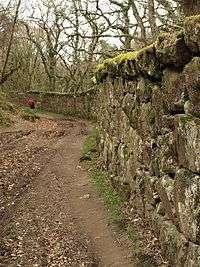John Whiddon
Sir John Whiddon (died 27 January 1576) of Whiddon in the parish of Chagford in Devon, was a Justice of the Queen's Bench from 4 October 1553 to his death on 27 January 1576,[2] during the reigns of Queen Mary I and Queen Elizabeth I.

Personal life
He was the son of John Whiddon of Chagford by his wife who was a member of the Rugg family of Chagford. His ancestors were resident in the parish of Chagford for at least six generations prior to the judge.[1]
Whiddon married twice. His first wife was Ann Hollis, daughter of Sir William Hollis, by whom he had a daughter, Joane, who married John Ashley of London.[1]
His second marriage was to Elizabeth Shilston, a daughter and co-heiress of William Shilston.[1] Among their eleven children were William, his eldest son and heir apparent, who predeceased his father without children, having married Eleanor Basset, a daughter of John Basset (1518–1541), and Francis (died 1606), fourth son,[1] whose granddaughter was the legendary Mary Whiddon.[3]
Their other sons included Edward (1537–1598), second and eldest surviving son and heir, who was admitted to the Inner Temple in 1559; Oliver, third son, who became Archdeacon of Totnes; and Nicholas (died 1598), who became Rector of North Bovey.[1]
Whiddon died on 27 January 1576.[1] His monument survives in St Michael the Archangel's Church, Chagford.[4][5]
Career
Whiddon entered the Inner Temple to study law and became Reader and later Double Reader and Treasurer of that Inn of Court. He was created a Serjeant-at-Law in 1547, and King's Serjeant in 1551. In 1553 Queen Mary I appointed him a Justice of the Queen's Bench.[7]
He is said by Dugdale in his Origines Juridiciales (1666) to have been the first judge who rode to Westminster Hall on a horse or gelding, before which time the judges rode on mules.[8][7] The manner of judges riding to Westminster Hall is recorded in the case of his father's contemporary Thomas Wolsey (1473–1530) as "trapped all in crimson velvet, with a saddle of the same and gilt stirrups".[7]
Landholdings
During the reign of Queen Elizabeth I (1558–1603) he purchased the manor of Chagford in Devon.[9] He built there on his ancestral estate within that manor a new mansion house at Whiddon, part of which survives today. He enclosed a deer park with the surviving wall built of massive granite blocks at the entrance to the Teign Gorge.[6]
References
- Vivian, Lt.Col. J.L., (Ed.) The Visitations of the County of Devon: Comprising the Heralds' Visitations of 1531, 1564 & 1620, Exeter, 1895, p. 781, pedigree of Whiddon of Chagford
- Sainty, John, The Judges of England 1272 -1990: A List of Judges of the Superior Courts, Oxford, 1993, p. 29
- Devon Perspectives – Chagford. Retrieved 7 January 2107.
- Pevsner, p. 250.
- See image in
- Pevsner, Nikolaus & Cherry, Bridget, The Buildings of England: Devon, London, 2004, p. 251
- Thoms, William J. (ed.) (L'Estrange, Nicholas & Aubrey, John & Collet, John), Anecdotes and Traditions, Illustrative of Early English History and Literature, London, 1839, p. 120, No CXCVI "A Judge on Horseback", quoting "Collet, p. 64"
- Thornbury, Walter, Old and New London, Volume 3, London, 1878, The Law Courts and Old Palace Yard, pp. 560–567
- Daniel Lysons and Samuel Lysons, Magna Britannia – Volume 6, Devonshire, 1822. p. 96.
Further reading
- Prince, John, (1643–1723) The Worthies of Devon, 1810 edition, London, biography of Whyddon, Sir John, Knight, Justice of King's Bench, pp.759-61
- Whiddon, Hayes L. Jr., The Whiddon Journey: From Medieval England to the New World, 2016, USA
